Opal Star: a kit that gleams
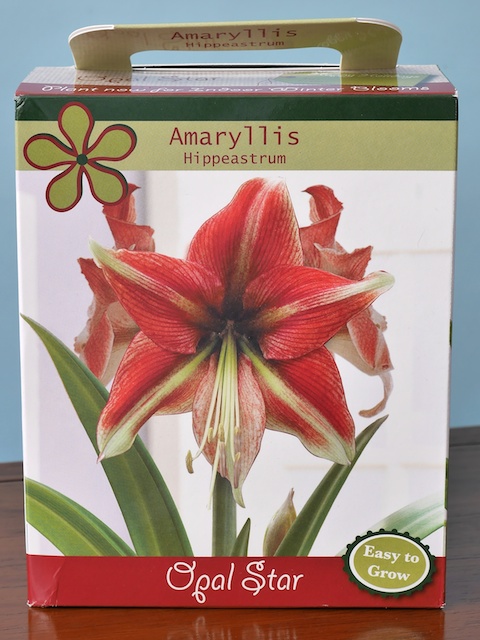
OK, first, the stats:
Cost: US $6.00 (on sale, regular price $7.99)
Date purchased: October 24, 2014
Date planted: October 26, 2014
Bulb size, in circumference: measured 28.5 cm, claim on box 26-28 cm
Pot size: 5″/13 cm
Bulb origin: Israel
Brand/Company: Garden State Bulb Co., NJ
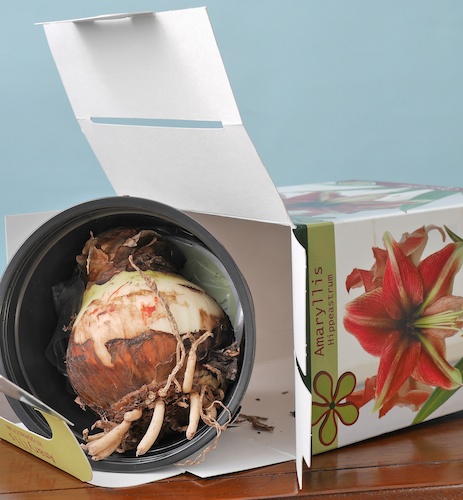
This was the kit that changed my mind this season. With the numerous and pricey options being offered by Royal Colors, this was to be the year of NO box kit feature, bonanza or otherwise. But Emaryllis has to eat, and therefore must enter the grocer’s realm on a regular basis. There…near the checkout, a display case filled with those colorful boxes. A red, a white…and…what? Could it be? I recognized the image even before getting close enough to read the name. ‘Opal Star’ as I live and breathe. Also eye-catching, the sign on the case: Special, 2/$12.00. And there went my resolve.
Knowing that ‘Opal Star’ is a patented variety from Saad-Assaf, it was no surprise to find that the bulb was grown in Israel. The other kits seem to feature offerings from the firm’s “non patented stock,” but who knows in this topsy turvy world of amaryllis gift boxes. Upon opening, a welcome surprise. A firm and healthy looking bulb that turns out to be slightly larger than the size indicated on the box, and it has actual, live roots! And it’s not sprouting out too much, just a few flexible leaves at the nose. That is especially key here, as the pot is turned up to the narrow side of the box. There is no room whatsoever if it does sprout a bloom scape. Being grown in the Northern Hemisphere means that it is more of a game to get them to force early enough for the winter holidays, rather than holding them back for months as is done in Brazil, South Africa, etc. These have been cool programmed precisely, and often part of that cool temperature treatment may occur on the ship carrying them across the Atlantic.
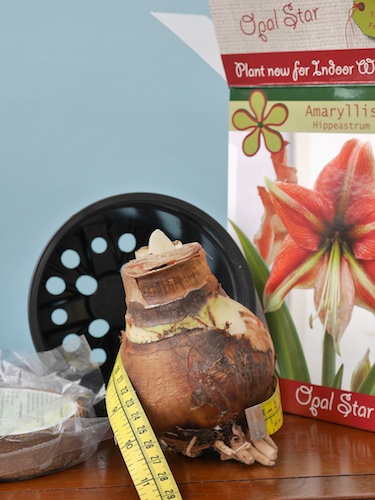
The pot itself is extremely thrifty. Lightweight plastic that is just big enough for the bulb, but it has outstanding drainage holes. The coir (from Sri Lanka) is soaked in warm water, and once expanded it yields plenty, especially considering the generous bulb size.
Now it is a simple matter of waiting. If you’ve been following Emaryllis, you know the drill on coconut coir. It is moisture retentive (a bit too much so), yet coarse enough to permit oxygen into the pot, so it can work if used properly. Properly in these parts means wringing the moisture out as much as possible at planting time, and watering in with some Bt israelensis (the type labeled for mosquito control or, our target, fungus gnats). Fungus gnats are not the worst pest that can visit an amaryllis, as the larvae spend most of their time eating dead organic matter; seedling roots they will dine on, but that’s not the problem here. The winged adults cruising around one’s home interior are quite the annoyance. They seek water and can often be found near sinks, toilets, or in the drinking glass next to your bed. House-guests are not impressed. I mix the granules into the coir itself, and for good measure keep a “mosquito dunk” or some bits of Bt in my watering vessels. It seems to work quite well.
And here we have it, December 21, just days before Christmas…a spectacular sight! Beautiful, clean foliage and a tall regally bedecked scape in…vivid…red? So vivid, so richly colored. Hmmm. Guess what, it’s not ‘Opal Star’, but its more brilliant stablemate ‘Ruby Star’. Sorry, ‘Opal Star’, you’re still very nice in a quieter way, but your sister here rocks the winter gloom away much more convincingly 😉 In conclusion, if we had to endure a substitute, this was actually better than the box promised. If you were looking to add ‘Opal Star’ to your collection you might disagree. I think that considering the overly color saturated image on the box, most would never even know that ‘Ruby Star’ was the stand-in. Perhaps both cultivars were actually used when packing these boxes, it wouldn’t surprise Emaryllis one bit.
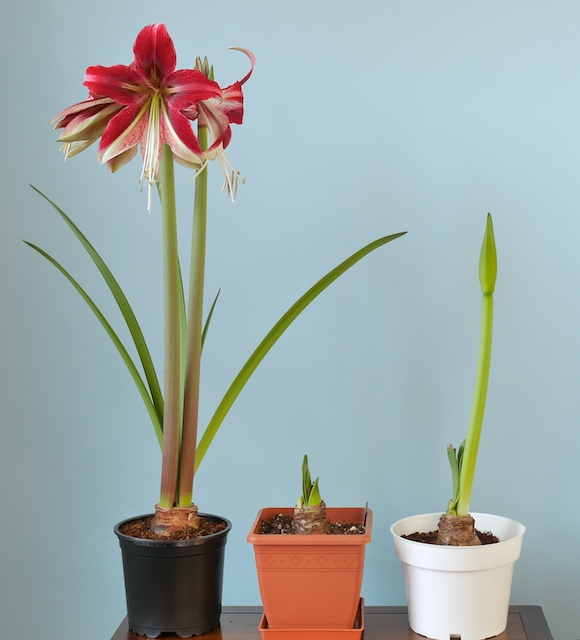
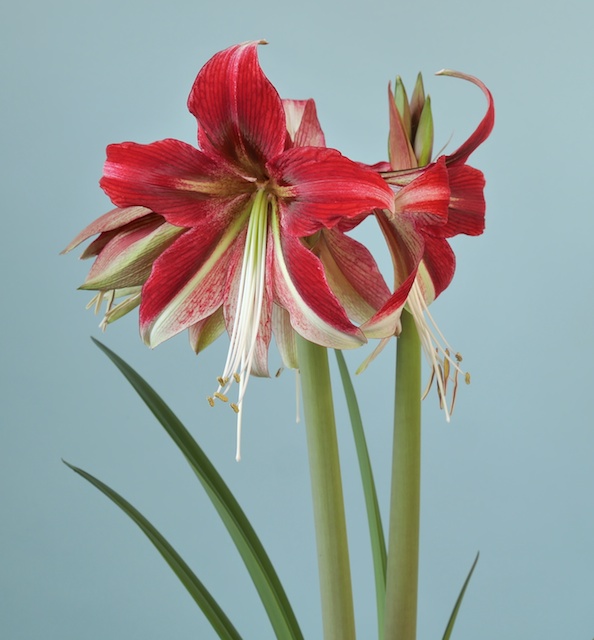
Below we have that second amazing scape. Unfortunately, the first was cut off prematurely, and there is a boo boo on the eldest flower here. The cause: a pot tipping over in the middle of the night. This is why I generally prefer heavier pots. While an unrooted bulb can list or lodge, even a rooted bulb in a snug pot can go crash, bang, boom in the night (causing nighttime panic and lost sleep here). A lightweight pot, lightweight media, and a robust, slightly leaning plant is all it takes. Now sleeved into a terra cotta pot for stability, it will be planted into such a pot if it is to hang around Rancho Emaryllis for another season. All in all, this was a great performance. If all we had to worry about was amazing vigor and productivity causing a topple, no qualms here. All kits should have such issues!
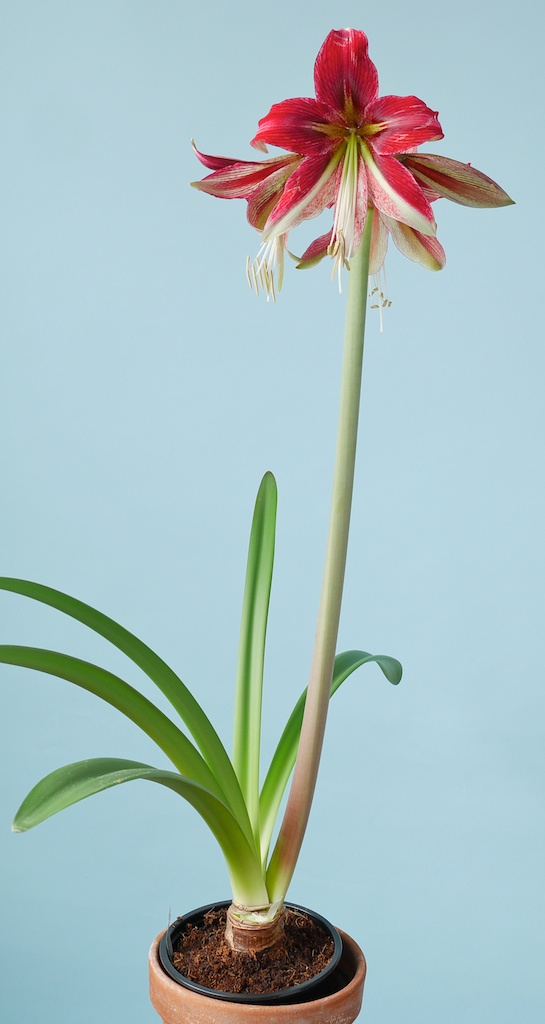
With eight stunning flowers produced, perfectly timed for the holiday season, this kit is a winner. Consider this: if you were to purchase ‘Ruby Star’ as a dry bulb (not pot, no media, no pretty box) it would probably run at least a few dollars more, and even if a bit larger, it would be hard pressed to beat this one in performance. Now I’m curious to know what surprises were waiting in those other boxes that shared the display case with this guy. Ahhh, next year!

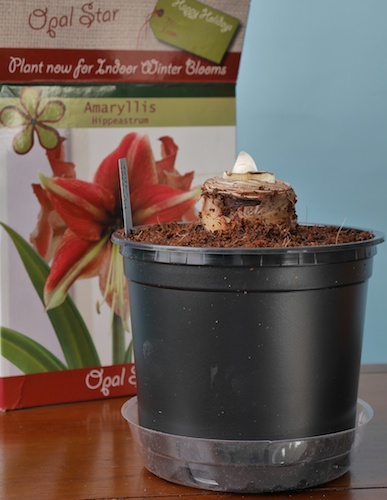
Leave a Reply